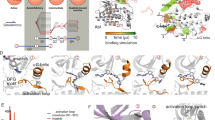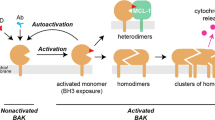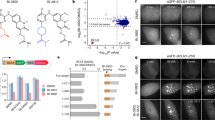Abstract
Auto-inhibition describes the capacity of proteins to adopt a self-imposed latent conformation. Recently, a crystal structure of the Abl tyrosine kinase has revealed its ability to auto-inhibit. However, a separate body of work suggests that other cellular proteins also inhibit Abl. To reconcile the crystal structure with Abl inhibitors, I propose that Abl is controlled by cellular 'co-inhibitors' that bind Abl, stabilizing the auto-inhibited conformation. The implication of co-inhibition on Abl function is discussed.
This is a preview of subscription content, access via your institution
Access options
Subscribe to this journal
Receive 12 print issues and online access
$209.00 per year
only $17.42 per issue
Buy this article
- Purchase on Springer Link
- Instant access to full article PDF
Prices may be subject to local taxes which are calculated during checkout


Similar content being viewed by others
References
Woodring, P.J., Hunter, T. & Wang, J.Y. Regulation of F-actin-dependent processes by the Abl family of tyrosine kinases. J. Cell Sci. 116, 2613–2626 (2003).
Puri, P.L. et al. A myogenic differentiation checkpoint activated by genotoxic stress. Nature Genet. 32, 585–593 (2002).
Wang, J.Y. Regulation of cell death by the Abl tyrosine kinase. Oncogene 19, 5643–5650 (2000).
Druker, B.J. et al. Efficacy and safety of a specific inhibitor of the BCR-Abl tyrosine kinase in chronic myeloid leukemia. N. Engl. J. Med. 344, 1031–1037 (2001).
Gorre, M.E. et al. Clinical resistance to STI-571 cancer therapy caused by BCR-Abl gene mutation or amplification. Science 293, 876–880 (2001).
Nagar, B. et al. Structural basis for the autoinhibition of c-Abl tyrosine kinase. Cell 112, 859–871 (2003).
Kemp, B.E. & Pearson, R.B. Intrasteric regulation of protein kinases and phosphatases. Biochim Biophys Acta 1094, 67–76 (1991).
Huse, M. & Kuriyan, J. The conformational plasticity of protein kinases. Cell 109, 275–282 (2002).
Robinson, D.R., Wu, Y.M. & Lin, S.F. The protein tyrosine kinase family of the human genome. Oncogene 19, 5548–5557 (2000).
Harrison, S.C. Variation on an Src-like theme. Cell 112, 737–740 (2003).
Barila, D. & Superti-Furga, G. An intramolecular SH3-domain interaction regulates c-Abl activity. Nature Genet. 18, 280–282 (1998).
Brasher, B.B. & Van Etten, R.A. c-Abl has high intrinsic tyrosine kinase activity that is stimulated by mutation of the Src homology 3 domain and by autophosphorylation at two distinct regulatory tyrosines. J. Biol. Chem. 275, 35631–35637 (2000).
Tanis, K.Q., Veach, D., Duewel, H.S., Bornmann, W.G. & Koleske, A.J. Two distinct phosphorylation pathways have additive effects on abl family kinase activation. Mol. Cell. Biol. 23, 3884–3896 (2003).
Nagar, B. et al. Crystal structures of the kinase domain of c-Abl in complex with the small molecule inhibitors PD173955 and imatinib (STI-571). Cancer Res. 62, 4236–4243 (2002).
Azam, M., Latek, R.R. & Daley, G.Q. Mechanisms of autoinhibition and STI-571/imatinib resistance revealed by mutagenesis of BCR-Abl. Cell 112, 831–843 (2003).
Hantschel, O. et al. A myristoyl/phosphotyrosine switch regulates c-Abl. Cell 112, 845–857 (2003).
Pluk, H., Dorey, K. & Superti-Furga, G. Autoinhibition of c-Abl. Cell 108, 247–259 (2002).
Wang, J.Y.J. Negative regulation of c-abl tyrosine kinase by its variable N-terminal amino acids. Oncogene Res. 3, 293–298 (1988).
Plattner, R. et al. A new link between the c-Abl tyrosine kinase and phosphoinositide signalling through PLC-γ1. Nature Cell Biol. 5, 309–319 (2003).
Wang, J.Y. Abl tyrosine kinase in signal transduction and cell-cycle regulation. Curr. Opin. Genet. Dev. 3, 35–43 (1993).
Wen, S.T. & Van Etten, R.A. The PAG gene product, a stress-induced protein with antioxidant properties, is an Abl SH3-binding protein and a physiological inhibitor of c-Abl tyrosine kinase activity. Genes Dev. 11, 2456–2467 (1997).
Wood, Z.A., Schroder, E., Robin Harris, J. & Poole, L.B. Structure, mechanism and regulation of peroxiredoxins. Trends Biochem. Sci. 28, 32–40 (2003).
Welch, P.J. & Wang, J.Y. A C-terminal protein-binding domain in the retinoblastoma protein regulates nuclear c-Abl tyrosine kinase in the cell cycle. Cell 75, 779–90 (1993).
Woodring, P.J., Hunter, T. & Wang, J.Y. Inhibition of c-Abl tyrosine kinase activity by filamentous actin. J. Biol. Chem. 276, 27104–27110 (2001).
Darnell, G.A. et al. Inhibition of retinoblastoma protein degradation by interaction with the serpin PAI-2 via a novel consensus motif. Mol. Cell. Biol. 23, 6520–6532 (2003).
Woodring, P.J. et al. Modulation of the F-actin cytoskeleton by c-Abl tyrosine kinase in cell spreading and neurite extension. J. Cell Biol. 156, 879–892 (2002).
Smith, K.M., Yacobi, R. & Van Etten, R.A. Autoinhibition of Bcr-Abl through its SH3 domain. Mol. Cell 12, 27–37 (2003).
Plattner, R., Kadlec, L., DeMali, K.A., Kazlauskas, A. & Pendergast, A.M. c-Abl is activated by growth factors and Src family kinases and has a role in the cellular response to PDGF. Genes Dev. 13, 2400–2411 (1999).
Foray, N. et al. Constitutive association of BRCA1 and c-Abl and its ATM-dependent disruption after irradiation. Mol. Cell Biol. 22, 4020–4032 (2002).
Yarden, R.I. & Brody, L.C. BRCA1 interacts with components of the histone deacetylase complex. Proc. Natl Acad. Sci. USA 96, 4983–4988 (1999).
Wang, Y. et al. BASC, a super complex of BRCA1-associated proteins involved in the recognition and repair of aberrant DNA structures. Genes Dev. 14, 927–939 (2000).
Baskaran, R. et al. Ataxia telangiectasia mutant protein activates c-Abl tyrosine kinase in response to ionizing radiation. Nature 387, 516–519 (1997).
Cong, F. et al. Cytoskeletal protein PSTPIP1 directs the PEST-type protein tyrosine phosphatase to the c-Abl kinase to mediate Abl dephosphorylation. Mol. Cell 6, 1413–1423 (2000).
Echarri, A. & Pendergast, A.M. Activated c-Abl is degraded by the ubiquitin-dependent proteasome pathway. Curr. Biol. 11, 1759–1765 (2001).
Kipreos, E.T. & Wang, J.Y. Differential phosphorylation of c-Abl in cell cycle determined by cdc2 kinase and phosphatase activity. Science 248, 217–220 (1990).
Barila, D. et al. Caspase-dependent cleavage of c-Abl contributes to apoptosis. Mol. Cell. Biol. 23, 2790–2799 (2003).
Hirotsu, S. et al. Crystal structure of a multifunctional 2-Cys peroxiredoxin heme-binding protein 23 kDa/proliferation-associated gene product. Proc. Natl Acad. Sci. USA 96, 12333–12338 (1999).
Acknowledgements
I wish to thank J. Zhu at the La Jolla Scientific Management for the artwork. I owe this perspective to the many talented investigators who have worked on Abl in my lab and around the world. Many worthy citations are omitted from this article solely because of page limits. Our work on Abl has been supported by the National Institutes of Health (USA).
Author information
Authors and Affiliations
Rights and permissions
About this article
Cite this article
Wang, J. Controlling Abl: auto-inhibition and co-inhibition?. Nat Cell Biol 6, 3–7 (2004). https://doi.org/10.1038/ncb0104-3
Issue Date:
DOI: https://doi.org/10.1038/ncb0104-3
This article is cited by
-
Distinctive roles of Abi1 in regulating actin-associated proteins during human smooth muscle cell migration
Scientific Reports (2020)
-
c-Abl regulates gastrointestinal muscularis propria homeostasis via ERKs
Scientific Reports (2017)
-
Critical role of actin-associated proteins in smooth muscle contraction, cell proliferation, airway hyperresponsiveness and airway remodeling
Respiratory Research (2015)
-
Role of Abl in airway hyperresponsiveness and airway remodeling
Respiratory Research (2013)
-
A role for c-Abl in cell senescence and spontaneous immortalization
AGE (2013)



